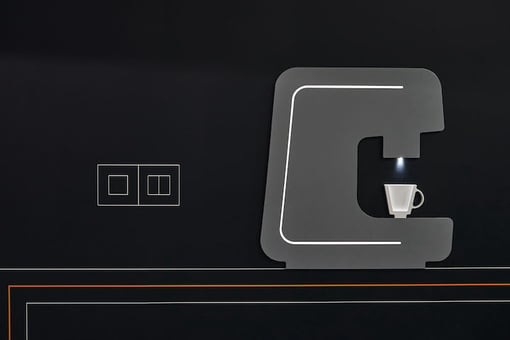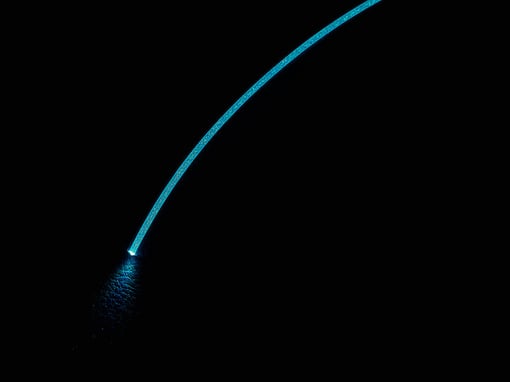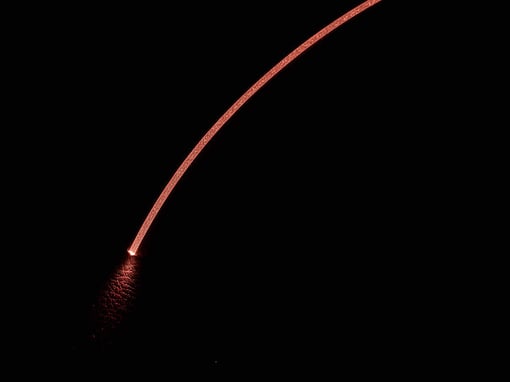
Side-emitting light optical fibre: what it is and how it works
Optical fibre is a device made up of glass or polymer filaments that allow light to be conveyed and guided through them. Optical fibres are used in various sectors, depending on the type of material they are made of: from telecommunications with glass filaments to lighting technology, from electronics to household appliances, to the automotive sector with plastic filaments.
The field of use of optical fibre has expanded exponentially: from being an essential factor for technological innovation to an aesthetic and design element, optical fibre has become one of the most sought-after solutions to obtain light effects with a primarily aesthetic purpose, which sometimes is also functional.
What do we mean by side-emitting light optical fibre, how does it work and what are its applications? Read on and find out everything you need to know.
Contents:
- Side-emitting light optical fibre: what it is and how it works
- Side-emitting light optical fibre: characteristics and applications
- Bending radius of optical fibre
- Optical fibre: diameter and dimensions
- SLIM and optical fibre solutions for light indicators
If you are interested in the topic, click on the button below in order to receive every detail about side-emitting light optical fibre!
Side-emitting light optical fibre: what it is and how it works
Side-emitting light optical fibre is an innovative technology that collects and propagates the light emitted by a light source, usually an LED, along a given path.
In telecommunication applications, optical fibre is characterized by a black outer sheath that prevents light dispersion, therefore allowing an adequate transmission of data and information. In side-emitting light optical fibre, on the other hand, a semi-transparent sheath is used and multiple microfractures are made on the sheath precisely to allow light dispersion to occur. The number and position of the microfractures, and the choice of the type of sheath, allow to adjust the dispersion of light and to obtain countless combinations of optical effects. This greatly influences the possibility of adapting the optical fibre to the demand of each user. In fact, it is an ideal technology to give free rein to creativity and the realization of customized solutions.
Side-emitting light optical fibre: characteristics and applications
The aesthetic effect obtained by using side-emitting light optical fibre could also be obtained by using an LED strip, which is readily available on the market. However, the solution with optical fibre has some particularly advantageous features to take into account. First of all a generally lower consumption: this technology allows to save even more than 50% compared to some solutions that use LEDs. Among the distinguishing features, there is also the homogeneity of light emission along the entire length of the fibre, without any concentration of light in the bending points and without light spots (even without the use of diffusers). Optical fibre is also an advantageous solution for the absence of heating and its total impermeability; in fact, it does not require any treatment, which is essential to increase the IP degree on the LED strips.
This technology is perfectly suited in the case of limited and uneven spaces and is an optimal solution to be used in various applications for household appliances, in the automotive sector, heating, ventilation and air conditioning systems, lighting engineering, home automation and control panels and in any other application where you want to add an aesthetic/functional light to improve the design.

Optical fibre, combined with the right light source, makes it possible to create perimeters and light profiles that perform better than a standard series of single lighting points in plastic that very often require the construction of dedicated equipment. This adds value to the final applications in terms of design and aesthetics. In fact, the use of optical fibre as a light profile for household appliances, furniture, swimming pools or display lighting helps to make the final product aesthetically appealing and, moreover, the combination with an RGB source can combine aesthetics with functionality through the combination of colour and application status.
Bending radius of the optical fibre cable
The possibility of replacing the inner part of the fibre with plastic materials (POF, Plastic Optical Giber) has given this product flexibility otherwise unthinkable with the use of materials with glass composition: this allows you to follow and illuminate profiles with even reduced optical fibre cable bending radius.
Since plastic material has bending and flexibility limits and exceeding such limits would lead to fibre breakage, the bending radius is a very important parameter to evaluate during the design stage. The basic rule to follow suggests maintaining a ratio between the diameter of the internal filament and the bending radius of 1 to 20. This means that if we use a fibre made up of filaments with a diameter of 2mm, the bending radius cannot be tighter than 40mm. It is also possible to go below this threshold, but in that case, special materials with greater flexibility must be used.
Optical fibre: diameter and dimensions
The outer diameter of the sheath of a standard solution ranges from 2 mm to 5 mm. Even in this case, the size and diameter of the optical fibre can change depending on the final application, according to the specific demand of the final client. As mentioned, this technology lends itself to greater customization: in addition to the external diameter of the optical fibre, it is possible to choose the degree of flexibility and the light source desired, depending on the final application. These possible variations, therefore, make it possible to obtain a functional and aesthetically attractive custom-made product.
SLIM and the optical fibre solutions for light indicators
SLIM designs, engineers and manufactures side-emitting light optical fibre solutions with high-efficiency 12V DC or 12-24V AC/DC light sources. You can request this product in different colours, depending on the intended use. Available colours are: white, blue, red, green, RGB and RGBW. During the initial consultation stage of the project, the user can also make specific requests regarding the material, the type of processing and the length of the optical fibre, as well as the need for specific supports and terminals.

The side-emitting light optical fibre light guide, in addition to being a high-quality product, has and adds the following advantages:
- the speed of development time;
- the possibility to adapt the fibre light guide to different applications;
- the possibility of customization through the change of the production set-up;
- the possibility of guaranteeing constant quality for all production batches;
- the unified control of the amount of light emitted and the place of emission.
Here is an example: Optical fibre: a solution for industrial lighting

Customized solutions for optical fibre light indicators manufactured by SLIM can be adapted to a variety of applications. Are you looking for an optical fibre solution? Click on the button below and do not hesitate to contact us, we will be happy to help you find the best solution for your needs!
